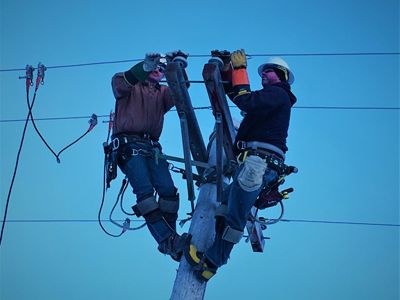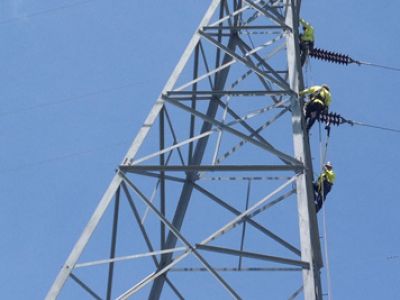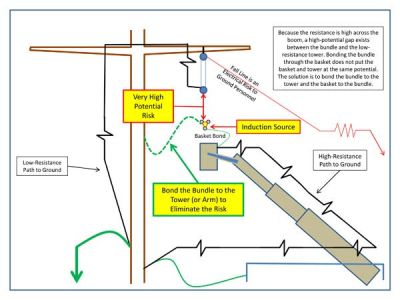
The Evolution of Personal Protective Grounding: Part 2
Part 1 of this article began with discussion of the first American power systems, when lineworkers initially encountered the hazards of working on de-energized lines (see https://incident-prevention.com/blog/the-evolution-of-personal-protective-grounding-part-1/). This led to early personal protective grounding (PPG) efforts using trial and error. We also reviewed Charles Dalziel’s contributions toward a greater industry understanding of dangerous current levels. […]

October-November 2025 Q&A
Q: We hear lots of opinions about whether a lineworker can lift a hot-line clamp that has a load on it. There is a rule that says disconnects must be rated for the load they are to break. We’ve been doing it forever. Are we breaking an OSHA rule or not? A: We have answered […]

Equipotential Grounding for URD Work
I have written about grounding for the protection of employees numerous times in Incident Prevention magazine, addressing both the law and other issues. Let’s begin this installment with the understanding that “grounding for the protection of employees” – which is the phrase OSHA uses – means establishing an equipotential zone or EPZ. The purpose of […]

The Evolution of Personal Protective Grounding: Part 1
Personal protective grounding, or PPG, is arguably the most critical safety procedure affecting contemporary lineworkers. Over time, it has evolved to include numerous significant elements that contribute to the success of today’s comprehensive methods and procedures. To adequately address these elements, this article will be presented in two parts. Part one, which you are now […]

Grounding Conductor Confusion: What’s the Best One to Use?
Consider new testing data before making a final determination. Proper grounding is both a life-and-death matter and an operational imperative. But many questions remain about grounding. Some of the most frequently asked include:
June-July 2018 Q&A
Q: Whenever we see graphics for single-point grounding, it’s always a cluster, a connection to the neutral, a connection to a phase and a chain connecting to the other two phases. But when we check with other utilities or consultants, we see all kinds of arrangements, such as bracket grounds with a single point or […]
August 2017 Q&A
Q: We are a contractor and were recently working in a manhole with live primary cables running through it. We were cited in an audit by a client’s safety team for not having our people in the manhole tied off to rescue lines. We had a tripod up and a winch ready for the three […]
June 2017 Q&A
Q: We have a group reviewing our personal protective grounding procedures, and they are asking if we should be grinding the galvanized coating off towers when we install the phase grounding connections. What are your thoughts? A: In addition to your question, we also recently received another question about connecting to steel for bonding, so […]

Equipotential Grounding: Lessons Learned in the Field
When the earliest linemen first began to ground lines for worker protection, they attached a small chain – known as a ground chain – to the conductors, with the end dropped to the ground. When I began to work on a line crew, I’m sad to say that my grounding practices weren’t much better than […]
December 2016 Q&A
Q: We hear lots of opinions on whether a lineworker can lift a hot-line clamp that has a load on it. There is a rule that says disconnects must be rated for the load they are to break. We’ve been doing it forever. Are we breaking an OSHA rule or not? A: Incident Prevention has […]

Safety Best Practices for Outage Season
Football season is here, and hunting season is right around the corner. That means it’s also outage season for the electric power industry. Planned outages allow utilities to take equipment out of service for maintenance, replacement or new construction. The timing is dictated by the utility owners and the regional transmission organizations that oversee the […]
June 2016 Q&A
Q: Is a transmission tower leg considered a lower level? And is there an exception for hitting a lower level when someone is ascending in the bucket truck to the work area? Our concern is that the shock cord and lanyard could be long enough that the person could hit the truck if they fell […]
Train the Trainer 101: Grounding for Stringing in Energized Environments
| Jim Vaughn, CUSP | Safety Management, Worksite Safety, Train the Trainer 101, Equipment Operations, Grounding
A few years ago I came upon a crew using 6-inch chocks to hold back a 38-ton crane truck. I told the crew I was happy that they were making an effort at compliance, but I had to ask them, “Why do we place chocks under a truck’s wheels? Is it to comply with our […]
February 2016 Q&A
Q: I work for a small utility and am new to my safety role. Recently I have been wading through the Federal Motor Carrier Safety Regulations (FMCSR) in an attempt to understand my responsibilities with regard to testing CDL drivers. Can you briefly explain these responsibilities? A: FMCSR 391.31 requires the employer to ensure a […]
December 2015 Q&A
Q: I’ve been reading ASTM 855, IEEE 1048 and the National Electrical Code, and I’m a little confused by the practice of grounding through a switch. Can you help me better understand this? A: In transmission/distribution applications, there is no issue with grounding through a switch. To explain, we always have to ask whether the […]
October 2015 Q&A
Q: Is equipotential grounding now a personal protective grounding method required by OSHA? A: The answer is yes, even though OSHA doesn’t specifically say so in terms we easily understand. The terminology isn’t OSHA’s fault. As an industry, we adopt certain familiar ways of describing or discussing things and simply don’t recognize what OSHA is […]

Train the Trainer 101: Practical Personal Protective Grounding
In the last 10 years I have consulted on dozens of induction incidents, eight of which resulted in fatalities. There were commonalities in each one. Just about every Incident Prevention reader will agree that one of the topics that receives the most attention across the power industry – in writing, training and conversation – is […]
Voice of Experience: Fundamentals of Underground Padmount Transformers
In recent months Incident Prevention has received several questions about underground (UD) padmount transformers, so in this installment of “Voice of Experience,” I’d like to take the time to cover the general aspects of these types of transformers. To begin, there are a few different types of single-phase and three-phase UD padmounts: live front with […]
June 2015 Q&A
Q: Are there any changes to steel-toe boot requirements for lineworkers in the recently revised OSHA 1910.269 standard? A: OSHA still leaves it to employers to decide whether hard-toe or protective footwear is required. As with all other PPE, the decision should be made based on risks and history. Wearing safety footwear is not required […]
December 2014 Q&A
Q: In regard to work boots and arc flash protection, what does OSHA mean by “heavy-duty work shoes or boots” in 29 CFR 1910.269(l)(8)(v)(B)? Are boots made of synthetic material acceptable if they are work boots? A: As with all OSHA rules, it is up to the employer to understand the risks and the necessary […]

